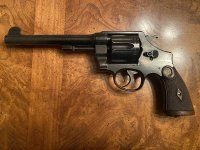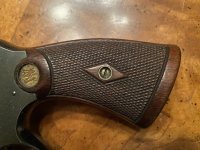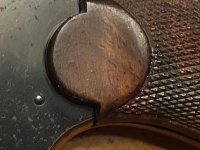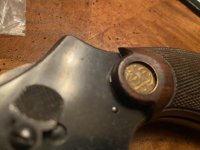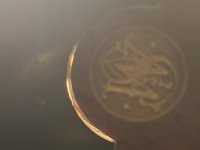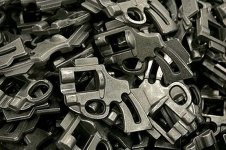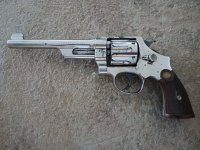I have never really gotten into collecting Colt First Generation Single Action Army revolver grips because the fit of the grips to various revolvers, as randomly fitted, is extremely poor. That is, the chances of a grip fitting a particular revolver is unlikely, in my experience.
In my collecting of Triple Lock and one .44 Hand Ejector Second Model revolvers over the years, I have replaced a sum total of two stocks on Triple Lock revolvers over the years. One came with totally incorrect stocks. Took one set I have collected over the years, placed them on this Triple Lock and a perfect fit. Second Triple Lock has condition issues, had a poorly fitting set of Mother of Pearl stocks, and I replaced them with a poor condition set of N frame stocks—and a nearly perfect fit, not being quite 100% attributed to the rough life these stocks have led.
I have collected about a dozen pre 1920 N frame stocks over the years, largely because my past experience of limited sample size (n=2), suggested with nearly 100% confidence that the engineering at Smith & Wesson was so good that the fit of all N frame stocks was such that by this 1908 to 1920 interval, any randomly selected set of stocks was interchangeable with another set and would fit any randomly selected revolver precisely, within reason.
And so, I just did an experiment. I randomly selected 7 sets of stocks and a control revolver to see if my long perceived theory was correct. (Spoiler: It is not!)
First: The control revolver, a 1916 production .44 Hand Ejector Second Model revolver, with factory original stocks, correct serial number penciled in on the backside of the right stock.
In my collecting of Triple Lock and one .44 Hand Ejector Second Model revolvers over the years, I have replaced a sum total of two stocks on Triple Lock revolvers over the years. One came with totally incorrect stocks. Took one set I have collected over the years, placed them on this Triple Lock and a perfect fit. Second Triple Lock has condition issues, had a poorly fitting set of Mother of Pearl stocks, and I replaced them with a poor condition set of N frame stocks—and a nearly perfect fit, not being quite 100% attributed to the rough life these stocks have led.
I have collected about a dozen pre 1920 N frame stocks over the years, largely because my past experience of limited sample size (n=2), suggested with nearly 100% confidence that the engineering at Smith & Wesson was so good that the fit of all N frame stocks was such that by this 1908 to 1920 interval, any randomly selected set of stocks was interchangeable with another set and would fit any randomly selected revolver precisely, within reason.
And so, I just did an experiment. I randomly selected 7 sets of stocks and a control revolver to see if my long perceived theory was correct. (Spoiler: It is not!)
First: The control revolver, a 1916 production .44 Hand Ejector Second Model revolver, with factory original stocks, correct serial number penciled in on the backside of the right stock.

